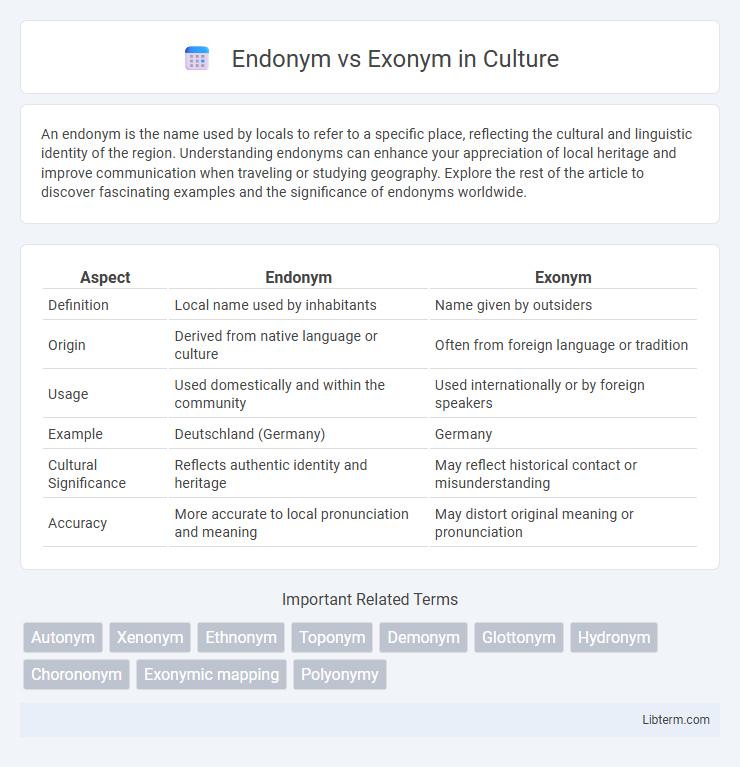An endonym is the name used by locals to refer to a specific place, reflecting the cultural and linguistic identity of the region. Understanding endonyms can enhance your appreciation of local heritage and improve communication when traveling or studying geography. Explore the rest of the article to discover fascinating examples and the significance of endonyms worldwide.
Table of Comparison
| Aspect | Endonym | Exonym |
|---|---|---|
| Definition | Local name used by inhabitants | Name given by outsiders |
| Origin | Derived from native language or culture | Often from foreign language or tradition |
| Usage | Used domestically and within the community | Used internationally or by foreign speakers |
| Example | Deutschland (Germany) | Germany |
| Cultural Significance | Reflects authentic identity and heritage | May reflect historical contact or misunderstanding |
| Accuracy | More accurate to local pronunciation and meaning | May distort original meaning or pronunciation |
Introduction to Endonyms and Exonyms
Endonyms are the names used by locals to identify a place, reflecting native language and cultural identity, such as "Deutschland" for Germany. Exonyms are foreign-language names given to places outside the speaker's own area, like "Germany" as used in English instead of the native endonym. Understanding the distinction between endonyms and exonyms is crucial in geography, linguistics, and international relations for accurate communication and respect for local heritage.
Definitions: What Are Endonyms and Exonyms?
Endonyms are the official names used by local people to refer to geographic locations, reflecting native language and cultural identity. Exonyms are alternative place names used by foreigners or outside groups that differ from the local designation, often adapting pronunciation or spelling. Understanding the distinction between endonyms and exonyms is crucial in linguistics, cartography, and international relations for accurate communication and representation.
Historical Origins of Endonyms and Exonyms
Endonyms and exonyms stem from historical linguistic and cultural interactions, with endonyms reflecting the self-designations used by indigenous populations for their own places or groups. Exonyms arise when external groups assign different names based on phonetic adaptation, colonization, trade, or geopolitical influence, often recorded in historical maps and documents. The evolution of these names reveals patterns of migration, conquest, and cultural exchange, highlighting how dominant powers imposed exonyms while preserving local identities through endonyms.
Cultural Significance of Place Naming
Endonyms carry deep cultural significance as they reflect the indigenous or local identity, history, and linguistic heritage of a place, fostering a sense of belonging and pride among its inhabitants. Exonyms often emerge from external perspectives or colonial histories, sometimes leading to misinterpretations or cultural erasure, which can impact geopolitical narratives and intercultural relations. Recognizing and respecting endonyms supports cultural preservation and promotes accurate representation of communities in global discourse.
Examples of Endonyms vs Exonyms Worldwide
Endonyms refer to the names used by local inhabitants to describe their own places, such as "Deutschland" for Germany and "Helsinki" for the capital of Finland. Exonyms are the names used by foreigners for these same locations, like "Germany" in English and "Reykjavik" often anglicized as "Reykjavik" rather than the local Icelandic "Reykjavik." Understanding the distinction between endonyms and exonyms highlights the cultural and linguistic diversity inherent in global place names.
Linguistic Impacts on Local and Global Identity
Endonyms reflect local linguistic identity by preserving native names that hold cultural significance and historical roots within a community. Exonyms, often used by outsiders, can influence global recognition and shape perceptions by adapting these names into foreign phonetic and linguistic frameworks. The tension between endonyms and exonyms underscores the ongoing negotiation of power, identity, and cultural respect in multilingual and multicultural contexts worldwide.
Endonyms and Exonyms in Maps and Media
Endonyms represent the local names used by inhabitants for geographical locations, providing authentic cultural and linguistic context on maps and in media, whereas exonyms are foreign-language names applied by outsiders. Maps that use endonyms enhance cultural accuracy and respect local identity, while media often employ exonyms to cater to broader audiences or simplify pronunciation. The choice between endonym and exonym usage impacts geographic literacy, cultural sensitivity, and the preservation of indigenous languages.
Political and Social Debates Around Naming
Endonyms, the names used by locals for their own places, often clash with exonyms, the names assigned by outsiders, stirring political tensions over cultural identity and sovereignty. These naming disputes frequently arise in regions with contested borders or historical conflicts, where the chosen name reflects national pride or suppression. Social debates center on respecting indigenous languages and heritage while navigating international recognition and diplomatic relations.
The Role of Endonyms and Exonyms in International Relations
Endonyms, the names used by local populations for their own places, reinforce cultural identity and political sovereignty, while exonyms, names assigned by outsiders, often reflect historical power dynamics and influence diplomatic interactions. Understanding the usage of endonyms and exonyms is crucial in international relations as it affects negotiation protocols, territorial disputes, and the recognition of states and ethnic groups. Sensitivity to endonyms promotes mutual respect and reduces conflicts, enhancing diplomatic communication and geopolitical stability.
Future Trends: Moving Towards Standardization
Future trends in the use of endonyms and exonyms indicate a movement towards standardization driven by increasing globalization and digital communication. International organizations like the United Nations Group of Experts on Geographical Names (UNGEGN) are promoting guidelines to harmonize geographical naming conventions worldwide. Advances in geospatial technology and multilingual databases further facilitate the adoption of standardized place names, enhancing consistency in mapping and navigation systems.
Endonym Infographic

 libterm.com
libterm.com